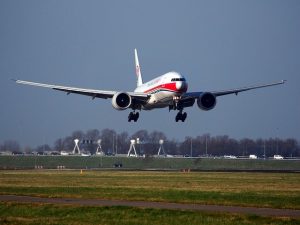 The speed and direction in which the wind blows can affect an airplane’s ability to land. If the wind is moving perpendicular to the runway at a relatively fast speed, pilots must adjust the airplane accordingly. Otherwise, they may land to the side of the runway rather than on it. The good news is that most pilots are familiar with this landing process. There’s even a word used to describe it: crosswind landing. What is a crosswind landing exactly, and how do pilots perform it?
The speed and direction in which the wind blows can affect an airplane’s ability to land. If the wind is moving perpendicular to the runway at a relatively fast speed, pilots must adjust the airplane accordingly. Otherwise, they may land to the side of the runway rather than on it. The good news is that most pilots are familiar with this landing process. There’s even a word used to describe it: crosswind landing. What is a crosswind landing exactly, and how do pilots perform it?
Overview of Crosswind Landings
A crosswind landing is a landing process that involves maneuvering an airplane so that it’s able to land in crosswinds. Crosswinds occur when the wind blows perpendicular to the runway. Wind, of course, can blow in any direction. It may blow parallel to the runway, in which case pilots can land their airplanes using a traditional landing process. If the wind blows parallel to the runway, however, pilots must perform a crosswind landing. This alternative landing process allows pilots to safely land in crosswinds.
Crosswinds are a concern for pilots because they can change the airplane’s point of attack and, therefore, prevent it from landing on the runway. As a result, pilots rely on crosswind landings to safely land airplanes in crosswinds.
How Crosswind Landings Are Performed
There are several different types of crosswind landings, each of which is performed in a different way. One of the most common types of crosswind landings is the crab landing. The crab landing means the airplane lands using crab only. As the airplane approaches the runway, it “crabs” into the wind, thereby minimizing drift to maintain proper alignment with the runway.
Along with the crab landing, another type of crosswind landing is the de-crab landing. The de-crab landing involves maintaining the airplane’s wings so that they are level at all times. The pilot will typically point the airplane’s nose into the wind, allowing him or her to safely land the airplane in crosswinds.
The crab landing and de-crab landing are just two of several crosswind landing techniques. Others include the sideslip landing, the forward slip landing and the sideslip approach landing.
In Conclusion
A crosswind landing is a type of maneuver that involves adjusting an airplane so that it can safely land on the runway during crosswinds. When the wind blows perpinedicular to the runway, pilots must perform a crosswind landing to ensure their airplanes safely reach the runway.



